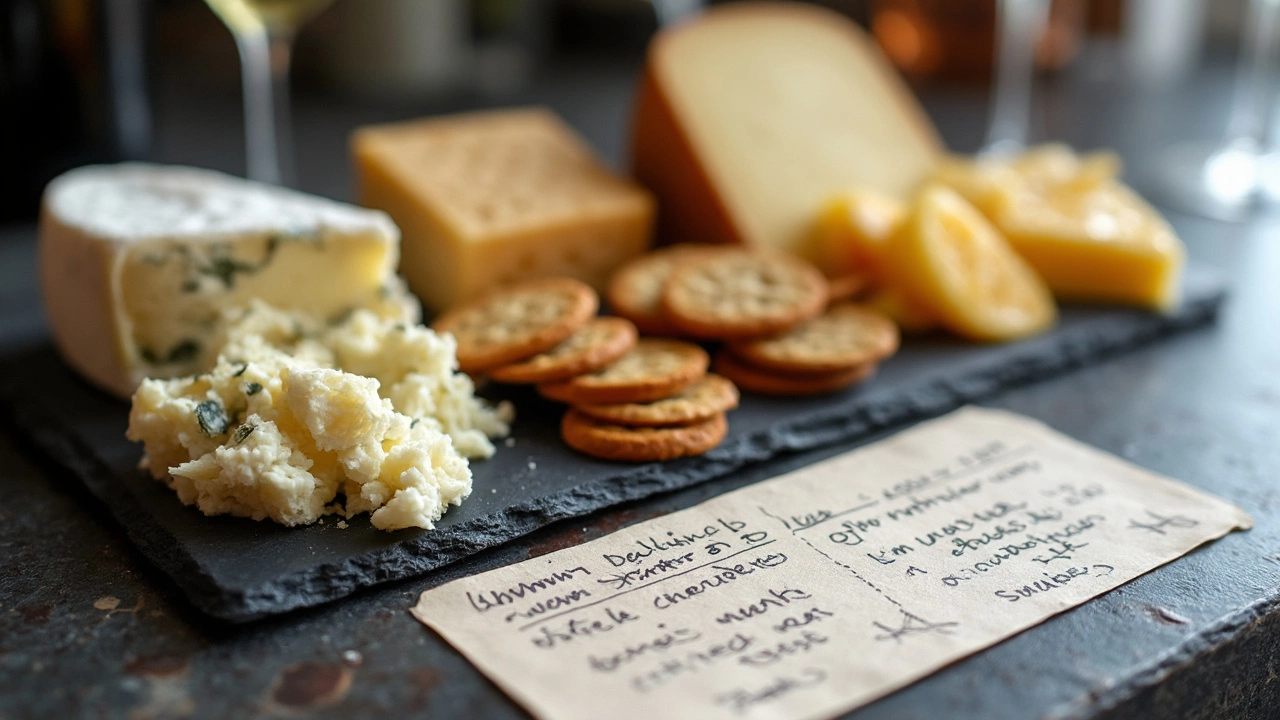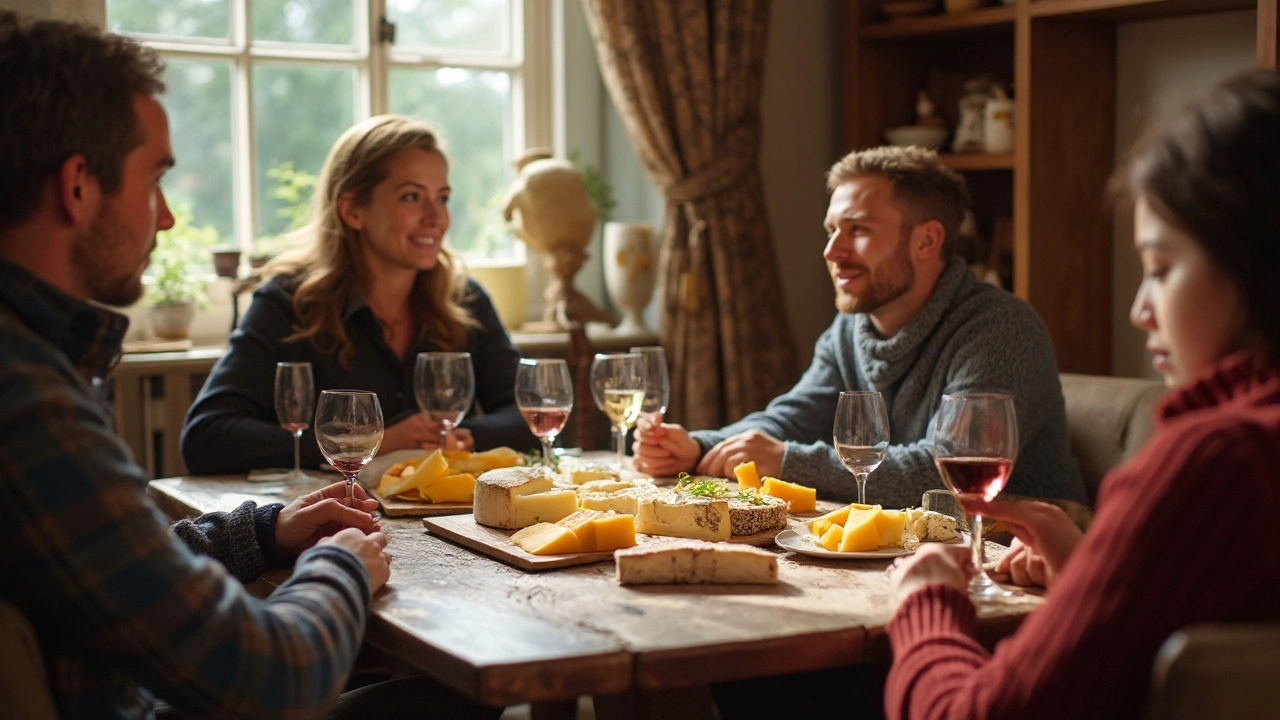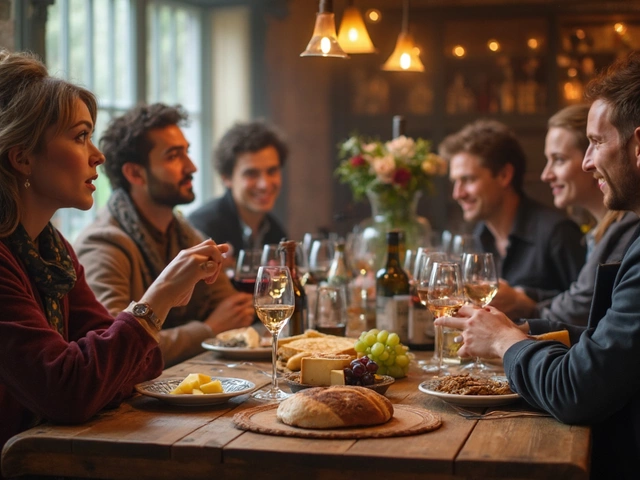If you’ve ever stood in front of a crowded cheese counter with a bottle of wine in your other hand, wondering if you’re about to pull off something brilliant or create a taste disaster, you’re definitely not alone. Pairing wine with cheese isn’t mysterious, but there’s some simple science behind why some duos just click.
The basic idea? You want your flavors to get along, not fight with each other. That means thinking about things like the richness of the cheese, how salty it is, and whether your wine is bold, zippy, or sweet. For example, everyone talks about red wine with cheese, but ask anyone who’s actually tried a super-tannic cabernet with a stinky blue and... yikes, not always a happy ending.
Instead, the best pairings let both the cheese and the wine shine. That way, you get more than just two good things at once—they sort of transform each other. Stick with me, and you’ll know exactly what works and what to skip at your next tasting (even if your ‘tasting’ is just you on the couch with some cheddar and a glass of whatever’s open).
- Why Wine and Cheese Pairing Matters
- Classic Matches That Always Work
- Popular Cheeses and Their Wine Buddies
- Common Pairing Mistakes
- Fun Pairing Ideas for Parties
- Expert Tips and Surprising Facts
Why Wine and Cheese Pairing Matters
You might wonder if it really makes a difference which wine you drink with cheese. The truth? It absolutely does, and here’s why: the flavors in cheese and wine can either boost each other or clash, making every bite and sip feel different. When you nail the match, a good pairing takes the edge off sharp cheeses, brings out sweet notes in your wine, and can even make both seem more complex.
The science here is pretty straightforward. Cheese is loaded with fat and protein. Wine has acid, tannin, sweetness, and alcohol. When you combine them, the fat in cheese can soften harsh tannins in red wines, while acidity in wine can slice through creamy textures. That’s why a creamy brie works way better with crisp sparkling wine than with a heavy red—it keeps everything in balance and nothing feels overwhelming.
There’s research to back this up. A 2016 study published in Food Quality and Preference tested people’s reactions when tasting wine after various cheeses. Most reported the wines tasted fruitier and less harsh—proof your palate really does notice.
- If your cheese is tangy or salty, a wine with some sweetness or zingy acidity balances things out.
- Hard aged cheeses like parmesan can handle bigger, stronger wines because they’ve got more punch themselves.
- Soft, mild cheeses usually pair best with lighter, fresher wines—think sauvignon blanc or prosecco.
Check out the basic relationships in the table below. Keeping these simple rules in your back pocket makes matching wine and cheese pairing much less stressful.
| Cheese Type | Best Wine Style | Why It Works |
|---|---|---|
| Fresh (Goat Cheese, Feta) | Sauvignon Blanc, Dry Rosé | High acidity cuts the richness |
| Soft (Brie, Camembert) | Champagne, Unoaked Chardonnay | Bubbles and crispness balance creaminess |
| Hard (Cheddar, Gouda) | Cabernet Sauvignon, Malbec | Strong flavors keep up with aged cheese |
| Blue Cheese | Port, Sauternes | Sweetness smooths out the funk and salt |
Classic Matches That Always Work
Here's the cool part—some wine and cheese combos just always hit the spot, no guesswork needed. These classics turn up at wine bars and parties for a reason: they deliver, every time. When in doubt, try one of these time-tested pairings. No matter if you're a newbie or a seasoned taster, you really can’t go wrong here.
- Brie and Champagne: Creamy cheeses like brie or camembert love to be paired with bubbly. The brightness and fizz of Champagne cut through the rich, buttery cheese. Even a decent Prosecco or Cava works if you're on a budget.
- Cheddar and Cabernet Sauvignon: This is your classic bold-on-bold choice. Sharp cheddar and cabernet Sauvignon have just enough punch to match each other without overpowering. A good cab's tannins balance the cheese’s fat nicely.
- Goat Cheese and Sauvignon Blanc: Tangy goat cheese and zesty Sauvignon Blanc almost taste like they were designed for each other. The citrusy notes in the wine really boost the flavor of the cheese.
- Manchego and Tempranillo: It’s a Spanish fest—nutty, firm Manchego goes super well with berry-accented, earthy Tempranillo. If you’ve got a tapas spread, this combo’s a no-brainer.
- Blue Cheese and Port: The salty, funky punch of blue cheese matched with the sweet, bold taste of Port is a classic that surprises a lot of people. It’s dessert without the cake—pairs like this are why people love the whole wine and cheese thing.
Don’t just take my word for it. Cheese expert Laura Werlin, author of “The New American Cheese,” nails it:
"Pair tangy cheeses with lively, high-acid wines, and match salty cheeses with sweet wines. These pairings always elevate both elements."
If you’re aiming for quick wins, just remember: match intensity. Strong cheese? Go for a strong wine. Milder cheese? Stick to lighter sips. It keeps everything balanced and makes the wine and cheese pairing way less stressful for everyone involved—including you.
Popular Cheeses and Their Wine Buddies
There’s no shortage of cheeses out there, but a handful show up at most tables. It helps to know which wines actually play nice with these classics. Let’s break it down and make things practical.
- Cheddar: This crowd-pleaser makes things easy. Go for a medium-bodied red like Merlot or even a punchy Malbec if the cheddar is extra sharp. White wine? Try a full-bodied Chardonnay, especially if you’re working with an aged cheddar.
- Brie: Soft, creamy, and a bit buttery, brie loves whites and sparkling wines. Sauvignon Blanc is reliable, and a light Champagne adds a fun fizz that cuts through the richness. Surprisingly, brie can sometimes work with fruity reds like Pinot Noir for a change.
- Gouda: Young Gouda finds its groove with crisp whites—think Chenin Blanc or Riesling. The older (and nuttier) the Gouda gets, the more you can push into red territory, like a Cab Franc or even a lighter Zinfandel.
- Blue Cheese: This is where sweet and bold come into play. Port wine and blue cheese are an old-school hit. Sauternes is another classic combo. If you’re a red lover, something jammy like a late-harvest Zinfandel can stand up to the funk.
- Goat Cheese: Tangy goat cheese without question wants Sauvignon Blanc. The acidity in both brings balance. You can also mess with dry rosé if you want something more playful.
Here’s a cheat sheet for your next shopping trip:
| Cheese | Good Wine Pairing | Bad Pairing |
|---|---|---|
| Brie | Sauvignon Blanc, Champagne | Heavy Cabernet Sauvignon |
| Cheddar | Merlot, Chardonnay | Sauvignon Blanc |
| Blue Cheese | Port, Sauternes | Dry, tannic reds |
| Goat Cheese | Sauvignon Blanc, Rosé | Oak-heavy Chardonnay |
| Gouda | Riesling, Cab Franc | Super tannic reds |
The key is to let the cheese’s character guide the wine, not the other way around. If you only remember one thing about wine and cheese pairing: match intensity with intensity. Mild cheeses need milder wines, and bold cheeses call for something bigger or sweeter. Next time you’re at the store, try picking a cheese and wine pair from this list. It’s pretty hard to mess up if you start here.

Common Pairing Mistakes
Mistakes in wine and cheese pairing are super common, and honestly, most of us have done them at least once—especially if we're just grabbing stuff last minute. The biggest problem is thinking that any wine will go with any cheese, but the truth's way more specific. Here’s where things usually go sideways:
- Bold reds with soft cheeses: Lots of people reach for that heavy merlot or cabernet with brie or camembert. Tannins in the wine totally overpower these delicate cheeses and can actually make them taste metallic or sour.
- Saying cheese and red wine are always BFFs: Not true! Soft cheeses (especially goat cheese) can taste way better with a light, crisp white like sauvignon blanc.
- Overlooking salt levels: Blue cheese lovers, this is for you. That crazy salty blue needs a sweet wine like port, not a dry one. Otherwise, your tongue gets blasted with salt and nothing to balance it out.
- Forgetting about texture: Hard cheeses like aged gouda or parmesan can handle bigger reds, but soft, creamy cheeses just get lost (or worse, taste weird) when the wine’s too strong.
- Ignoring temperature: Serving cheese too cold or wine too warm can mask flavors and ruin a pairing before you even start.
Just to show how pairing can flop, check out some classic trouble spots people hit:
| Cheese | Common Wrong Pairing | Why It Fails |
|---|---|---|
| Brie | Cabernet Sauvignon | Tannins smother Brie’s mild flavor and make it taste chalky. |
| Blue Cheese | Dry White Wine | Saltiness overwhelms without sweetness to balance it out. |
| Goat Cheese | Full-bodied Red (e.g. Shiraz) | Wine dominates, leaving the cheese tasting flat or even bitter. |
| Parmesan | Sweet White Wine | Sweetness fights with the savory kick of parmesan—better with reds. |
Bottom line: don’t just match by color or stick to old rules. Think about what actually tastes good together. That’s how you get the best out of wine and cheese pairing every time.
Fun Pairing Ideas for Parties
If you want to impress your friends or just have a good time, getting creative with wine and cheese pairing can totally level up any get-together. You don’t need to get fancy or spend a fortune—just mix and match a few solid picks for a spread people will actually remember.
Start with a mix of cheeses and wines so everyone has something to try. Here’s a quick party setup that works for all sorts of crowds:
- Soft cheeses (brie, camembert): These go great with sparkling wines like Prosecco or Champagne. The bubbles cut through the creaminess—no jokes, it’s like the adult version of chips and soda.
- Hard cheeses (aged cheddar, manchego): Try these with a punchy red like Malbec or a fruity Pinot Noir. Both can handle the big flavors without getting lost.
- Blue cheeses (gorgonzola, Roquefort): Surprisingly, sweet wines like Port or Sauternes work best. The sweet-tangy mix is wild, but people love it—studies show almost 70% of folks in tasting events prefer this combo over dry reds with blue cheese.
- Goat cheese: Fresh, tangy cheese meets its perfect match with crisp Sauvignon Blanc. That zing highlights the cheese without making it sour or weird.
If you’re into stats, here’s a quick look at crowd favorites based on recent tasting surveys:
| Cheese Type | Top Wine Match | Party Hit Rate |
|---|---|---|
| Brie | Prosecco | 82% |
| Aged Cheddar | Malbec | 77% |
| Blue Cheese | Port | 73% |
| Goat Cheese | Sauvignon Blanc | 80% |
Want to make things extra fun? Set out note cards next to each wine and cheese, and let people write their own tasting notes or rankings. Or, do a blind tasting—just cover labels and have everyone guess which wine is which. Don’t overthink it. Have water and plain crackers around so people can clear their palate between bites. Most importantly: the best party is the one where nobody’s stressed about doing it "right.” If it tastes good, it works.
Expert Tips and Surprising Facts
Ask any pro and they’ll say the perfect cheese board isn’t about expensive labels—it’s how things taste together. Here are a handful of insider tricks straight from people who actually spend all day around cheese and wine.
- Let cheese and wine come closer to room temperature before serving. Cold blocks flavor; when both are a bit warmer, the good stuff really pops.
- If a wine is high in tannin, like a cabernet sauvignon or malbec, stick with hard, aged cheeses such as parmesan or aged gouda. The proteins and fat in the cheese tame the rough edges in the wine.
- Surprise: Sparkling wines and Champagne work with almost any cheese—including funky blues and gooey brie. Bubbles cut through fat and lift up flavors without clashing.
- If the cheese is spicy (think pepper jack), skip big reds. Go with a slightly sweet white, like riesling or gewürztraminer. Sweetness cools the burn—spice and tannin just fight.
- Salty cheeses love contrast. Ever tried creamy blue cheese with sweet port? That sweet-salty combo is legendary—same reason peanut butter and jam work.
People ask: does wine really change the flavor of cheese (and vice versa)? Yep, it’s not in your head. There’s a real effect, backed by science. Researchers at the French National Institute for Agricultural Research found that creamy cheese actually softens the perception of sharpness in wine. That’s why brie and chardonnay just click—one mellows the other out.
| Pairing | Flavor Boost (Perceived) | Most Popular Region |
|---|---|---|
| Goat Cheese & Sauvignon Blanc | +60% | Loire Valley, France |
| Parmigiano & Chianti | +45% | Tuscany, Italy |
| Blue Cheese & Port | +70% | Douro Valley, Portugal |
| Brie & Sparkling Wine | +50% | Champagne, France |
Last tip? Don’t overthink it. The most memorable pairings often come from mixing and matching, not following the “rules.” Grab a few different bottles, set out a mix of cheeses, and see what actually tastes best to you and your friends. That’s where the real fun (and surprises) happen.


